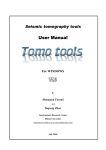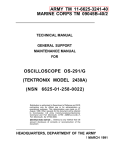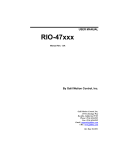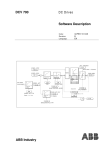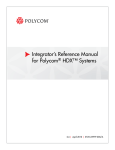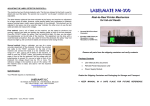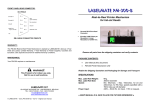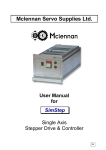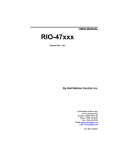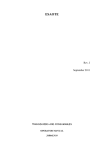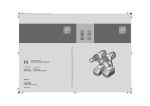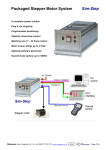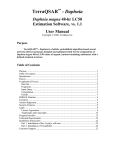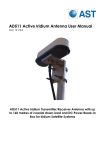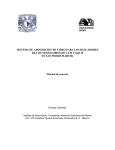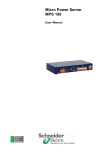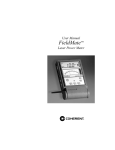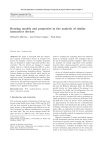Download USER`S MANUAL FOR PM368
Transcript
Mclennan Servo Supplies Ltd. User Manual For PM368 Incremental Encoder Display PM368 HANDBOOK REV 1.0 USER'S MANUAL FOR PM368 Mclennan servo supplies ltd Yorktown Industrial Estate 22 Doman Road Camberley Surrey GU15 3DF Telephone: Camberley (01276) 26146 FAX: Camberley (01276) 23452 Email: [email protected] PM368 HANDBOOK REV 1.0 The manufacturer reserves the right to update the data used in this manual, in line with product development, without prior notice. THIS MANUAL COVERS ROM VERSION 1.0 Mclennan Servo Supplies Ltd. PM368 HANDBOOK REV 1.0 CONTENTS DESCRIPTION .............................................................................................................1 ENCODERS..................................................................................................................2 OTHER INPUTS AND OUTPUTS ................................................................................2 RS 232 INTERFACE CONNECTIONS .........................................................................3 DIL SWITCH .................................................................................................................4 COMMAND WORD SYNTAX .......................................................................................6 Replies .......................................................................................................................6 PROGRAMMING THE UNIT.........................................................................................7 GENERAL COMMANDS............................................................................................7 SCALING FACTORS .................................................................................................7 DISPLAY FUNCTIONS ..............................................................................................7 QUERYING VALUES AND SETTINGS .....................................................................9 SET AND RESET POSITION FUNCTIONS ............................................................10 ERROR MESSAGES...............................................................................................11 SUMMARY TABLE OF COMMANDS ......................................................................12 PM368 REAR CONNECTOR PIN ASSIGNMENTS AND FUNCTIONS .....................13 Input and output specifications: ...............................................................................14 MSB143 MOTHERBOARD ..............................................................................................15 PM368 HANDBOOK REV 1.0 DESCRIPTION The PM368 is an RS232 interfaced Eurocard-format intelligent incremental encoder display. It is available in two forms: The PM368S single axis display. The PM368D dual axis display. The PM368 will continuously monitor the position of an encoder and display the position on a front panel mounted, seven-digit display. This position may be scaled into working units. It is also possible to display the current velocity of the encoder. The display is designed to act as a standard 1 to 1 display in its default condition but may be configured for functions that are more useful. All set up parameters are sent using commands in ASCII format, sent down the RS232 data path in a similar format to PM300 series controllers. These parameters are stored in the on-board battery backed RAM and persist after power down. Commands may be sent from, and replies received by a terminal or computer. A number of the displays or controllers may be daisy chained on a single RS232 port, since each command is prefixed with a number defining the axis to be addressed. It will simply "pass on" a command preceded by a number other than its own. Each axis display has a 'RESET' button below it. This button must be pressed for at least one second. It will only function if it is enabled by both hardware and software. The reset position may be set to a position other than its default of zero. If the number to be displayed exceeds the scope of the seven digits of the display, then it will display HHHHHHHH for a number too big or LLLLLLLL for a number too negative. The displays may also be put into 'RETENTION MODE' (or remember mode) so that the positions are retained after power down. These positions will flash to show that they may not be accurate (if the axis has moved whilst the power was off). They may be accepted as valid positions by a reset, either by the front panel pushbutton or by external reset. After this has been done, the flashing will cease. Subsequent resets will perform their usual function. PM368 Printed on 13 July, 1999 1 PM368 HANDBOOK REV 1.0 ENCODERS The encoder should be of the quadrature type. All of the transitions on both tracks of the encoder are counted, giving an overall count of four times the number of pulses per revolution of each track, see below: Nominal count (pulses / rev) 1 2 3 4 | | | | +-----+ +-----+ +-----+ +-----+ Channel A | | | | | | | | --+ +-----+ +-----+ +-----+ +| | | | | | | | | +-----+ | +-----+ | +-----+ | +-----+ Channel B | | | | | | | | | | | | | | | | --+ | +-----+ | +-----+ | +-----+ | +-| | | | | | | | | | | | | | | | 4 x resolution 1 2 3 4 5 6 7 8 9 10 11 12 13 14 15 16 The unit has inputs for either TTL output (or sinking open-collector output) or the more preferable RS422 complementary output type. An on-board switch selects between the two sets of inputs for each axis; SW2 for the first axis, SW3 for the second axis. The regulated 5 volt output may be used to power the encoder. The leads to the encoder should be screened, with the screen grounded. There are also open-collector encoder outputs for connection to controllers etc. If the sense of direction of the encoder is wrong, it may be reversed by either swapping the A & B signals or by simply setting the scaling factor to a negative value. Ranges of suitable encoders are available for use with the PM368 displays. Mclennan Servo Supplies sales office for more information. Please contact the OTHER INPUTS AND OUTPUTS The PM368 has a number of inputs that are pulled-high internally to +5V. They may accept TTL. signals or may be pulled low to 0V by a switch, open collector driver or an opto-isolator. For each axis, there are the following inputs: FPRESETEN The front panel reset button is not enabled unless this input is low. EXTRESET The display is immediately reset to the reset position when this input is low. There is also the following general input: DISPBLANK All displays of the unit are blanked when this input is low. For each axis, there is the following open-collector output: RESETOUT PM368 This output is pulled low if the displayed number is not within the window of the reset position. Printed on 13 July, 1999 2 PM368 HANDBOOK REV 1.0 RS 232 INTERFACE CONNECTIONS The PM368 module accepts instructions from the RS232 serial data input. (N.B. - Transmitted characters are not echoed back to the terminal.) The RS232 is configured in a three-wire format. No handshaking is used. For PM368 pin number identification, please refer to connector diagram. Connections to three-wire DTE (Data Terminal Equipment). D.T.E. PM368. Tx +---------------------------------+ Rx Port 1 Rx +---------------------------------+ Tx Port 1 Signal Ground +---------------------------------+ 0v Port 1 Connections for PM300 series multi-axis applications: "Port 1" connections are as shown above, further PM300 series displays or controllers are then "daisychained" as shown here: Connections with three-wire DTE. PM3xx controller or display PM368 Next PM3xx controller or display Tx Port 2 +---------------------------------+ Rx Port 1 Rx Port 2 +---------------------------------+ Tx Port 1 0v Port 2 +---------------------------------+ 0v Port 1 Printed on 13 July, 1999 3 PM368 HANDBOOK REV 1.0 DIL SWITCH On the PM368 board will be found an 8 row dual-in-line switch this designates the axis address number of the device and protocol of the RS232 data bus. The functions of the eight switches are defined in the tables below. N.B. In these tables, 1=ON, 0=OFF. +===========+==================++=======================+=======+ |SWITCH NO. | RS 232 MODE || SWITCH NUMBER. | AXIS | +-----+-----+ |+-----+-----+-----+-----+ADDRESS| | 6 | 5 | DATA FORMAT || 4 | 3 | 2 | 1 | | +=====+=====+==================++=====+=====+=====+=====+=======+ | 0 0 |7 BITS,EVEN PARITY|| 0 0 0 0 | 200 | +-----------+------------------++-----------------------+-------+ | 0 1 |7 BITS,ODD PARITY || 0 0 0 1 | 201 | +-----------+------------------++-----------------------+-------+ | 1 0 |7 BITS,ZERO PARITY|| 0 0 1 0 | 202 | +-----------+------------------++-----------------------+-------+ | 1 1 |8 BITS,NO PARITY || 0 0 1 1 | 203 | +===========+==================++-----------------------+-------+ | 0 1 0 0 | 204 | +===========+==================++-----------------------+-------+ |SWITCH NO. | RS 232 MODE || 0 1 0 1 | 205 | +-----+-----+ |+-----------------------+-------+ | 8 | 7 | BAUD RATE || 0 1 1 0 | 206 | +-----+-----+------------------++-----------------------+-------+ | 0 0 | 9600 || 0 1 1 1 | 207 | +-----------+------------------++-----------------------+-------+ | 0 1 | 4800 || 1 0 0 0 | 208 | +-----------+------------------++-----------------------+-------+ | 1 0 | 1200 || 1 0 0 1 | 209 | +-----------+------------------++-----------------------+-------+ | 1 1 | 300 || 1 0 1 0 | 210 | +===========+==================++-----------------------+-------+ | 1 0 1 1 | 211 | +-----------------------+-------+ | 1 1 0 0 | 212 | +-----------------------+-------+ | 1 1 0 1 | 213 | +-----------------------+-------+ | 1 1 1 0 | 214 | +-----------------------+-------+ | 1 1 1 1 | 215 | +=======================+=======+ Example: When the switch is set as shown here, +-------------+---+---+---+---+---+---+---+---+ | Switch No: | 8 | 7 | 6 | 5 | 4 | 3 | 2 | 1 | +-------------+---+---+---+---+---+---+---+---+ | State: | 0 | 0 | 1 | 1 | 0 | 0 | 1 | 1 | +-------------+---+---+---+---+---+---+---+---+ the PM368 would respond to commands prefixed by the number 203, and can be addressed at a baud rate of 9600. The data format would be 8 data bits, NO parity and 1 stop bit. PM368 Printed on 13 July, 1999 4 PM368 HANDBOOK REV 1.0 NOTE: The second axis of the PM368D display is addressed as one more than the number of the first axis. I.E. the above number +1. PM368 Printed on 13 July, 1999 5 PM368 HANDBOOK REV 1.0 COMMAND WORD SYNTAX Most commands are two letters, the function of each, being described below. Each command is preceded by the appropriate address to identify the axis for which the command is intended. Where applicable (e.g. setting of system parameters, etc.) the command should then be followed by the desired value: aXXnnn a = address XX = command nnn = value (if required) Command strings should be terminated with a carriage return character (ASCII 0C hex). Upper or lower case characters may be used for the command. Spaces within the command line are ignored. Replies Responses to commands are prefixed by the axis address number followed by ":", and then either "OK" or an alpha-numeric string (depending on the command being responded to) once the command has been accepted. Each line terminates in carriage return (0C) and line feed (0A). Each response is terminated with a null character (00). If an error situation is created, an error message appropriate to a mistake or conflicting instruction is sent. Error messages have a "!" after the ":". See Error Messages p10. All commands with the exception of Control C and ESC are buffered so that a write-ahead approach to programming may be used. Commands are executed in consecutive order. ALL SET-UP PARAMETERS RELATING TO THE BEHAVIOUR OF THE DISPLAY WILL BE HELD IN THE BATTERY-BACKED RAM ON POWER-DOWN. THEY WILL REMAIN AT THE PREVIOUSLY SET VALUES UNTIL ALTERED VIA THE RS 232 BUS. PM368 Printed on 13 July, 1999 6 PM368 HANDBOOK REV 1.0 PROGRAMMING THE UNIT N.B. Commands are buffered and will only be executed after completion of the previous command. GENERAL COMMANDS IDENTIFY ID The command ID returns the software version. The string is of the form "PM368S single axis VER 1.0" or "PM368D dual axis VER 1.0". HELP HE Displays a memory jogging list of commands available and their function. DEFAULT VALUES DV Set all constants to default values. I.E. 1:1 scaling, position display etc. SCALING FACTORS The incoming encoder pulses are multiplied by the numerator and divided by the denominator to give a scaled number. These may be set to give a display in working units (e.g. millimetres, degrees etc.). ENCODER NUMERATOR Range: ± 1-32767 EN Set the numerator for the scaling factor to the value specified. Default: 1 ENCODER DENOMINATOR Range: ± 1-32767 ED Set the denominator for the scaling factor to the value specified. Default: 1 DISPLAY FUNCTIONS POSITION DISPLAY PD Set display mode to display the scaled position of the encoder. VELOCITY DISPLAY VD Set display mode to display the scaled velocity of the encoder. DIFFERENCE DISPLAY Dual Axis Version Only DD Set display mode to display the difference between the scaled positions of this axis and the other axis of this module. BLANK DISPLAY BD Set display mode to blank display. All data is still accessible via RS232 interrogation. PM368 Printed on 13 July, 1999 7 PM368 HANDBOOK REV 1.0 DECIMAL POINT POSITION DP Select decimal point position. Range: 0 - 7 Default: 0 ± . 8 . 8 . 8 . 8 . 8 . 8 . 8 7 6 5 4 3 2 1 Position zero (default) displays no decimal points. NOTE: This is purely a displaying function and does not affect the displayed number. Please adjust scaling factors to give required number. LEADING ZERO SUPPRESSION LZ Set leading zero suppression mode. LZ0 LZ1 Range: 0 or 1 Default: 0 Leading zero suppression ON. E.G. 37.84 Leading zero suppression OFF. E.G. 00037.84 Range: 5 - 10000 Default: 5 multiples of 5 only! Set the gate time between updating the display in milliseconds. This value is also used for the averaging time for the velocity display and may be set higher to give a more accurate, but less frequently updated display. GT GATE TIME RETENTION MODE RM Set retention (remember) mode. RM1 RM0 PM368 Range: 0 or 1 Default: 0 Retention mode ON. Retention mode OFF. Printed on 13 July, 1999 8 PM368 HANDBOOK REV 1.0 QUERYING VALUES AND SETTINGS OUTPUT ENCODER POSITION OE Interrogate and return the current unscaled encoder position. This would normally only be used when setting up a system. OUTPUT ACTUAL POSITION OA Interrogate and return the current scaled encoder position. Decimal points are not given. OUTPUT VELOCITY OV Interrogate and return the current velocity of the encoder. This is averaged over the gate time set for this axis. QUERY ALL QA Interrogate and return all current set-up parameters etc. in the following format: 201: Encoder Position Scaled Position Encoder Numerator Encoder Denominator Reset Position Window Gate Time Front Panel Reset Display Mode Retention Mode = = = = = = = = = = 0 0 1 1 0 0 5 Enabled Position On NOTE that the 'Front Panel Reset' only shows if it is software enabled and does not take account if the external hardware enable is active. PM368 Printed on 13 July, 1999 9 PM368 HANDBOOK REV 1.0 SET AND RESET POSITION FUNCTIONS ACTUAL POSITION Range: ± 0 - 2147483647 AP Set the current actual (scaled) position to the value given. This does not affect the raw encoder position. SET RESET POSITION Range: ± 0 - 2147483647 Default: 0 SR Set the reset position to the value given. When a future reset occurs, by either from the front panel reset button, external reset input or by a power-up reset, the position will be set to this value. WINDOW Range: ± 0 - 2147483647 Default: 0 WI Set the window for the 'RESETOUT' output. This output will be pulled low if the displayed number is more than this window away from the Reset Position. Because this acts on the displayed number, it will work for a velocity or difference display. This output will therefore only be updated as often as the gate time for that axis. ENABLE FRONT PANEL RESET Default: Enabled ER Enable the front panel reset button by software. The external 'FPRESETEN' input signal must also be enabled for the button to function. INHIBIT FRONT PANEL RESET IR Disable the front panel reset button by software. PM368 Printed on 13 July, 1999 Default: Enabled 10 PM368 HANDBOOK REV 1.0 ERROR MESSAGES In the normal course of programming the PM368, the device responds to a standard command input by replying with an "OK" answer to the programmer once the command has been accepted, (see previous page for string format). Alternatively, if the command is to query a value or constant, the PM368 simply gives the numeric answer. However, the user may encounter "error messages" appropriate to a mistake or conflicting instruction, the meaning of which is usually self-explanatory, but are explained below: 200:! ILLEGAL COMMAND ! Command not recognised by the PM368. Self-explanatory but often seen when miss-keyed commands are sent! 200:! OUT OF RANGE ! Command numeric value is higher or lower than allowed. (See "command syntax" section.) 200:! ZERO NOT VALID ! The numeric value of zero (or if omitted) is not valid. 200:! MUST BE DIVISIBLE BY 5 ! The numeric value attempted was not a multiple of 5. PM368 Printed on 13 July, 1999 11 PM368 HANDBOOK REV 1.0 SUMMARY TABLE OF COMMANDS PAGE GENERAL COMMANDS ID IDentify the type and software version HE return HElp page DV set parameters to Default Values 6 6 6 SCALING FACTORS EN<value> set Encoder Numerator ED(value> set Encoder Denominator 6 6 DISPLAY FUNCTIONS PD set to Positional Display mode VD set to Velocity Display mode DD set to Difference Display mode BD set to Blank Display mode DP<0-7> set Decimal Point position LZ<0/1> set Leading-Zero suppression mode GT<5-10000> set Gate Time in milliseconds RM<0/1> set Retention Mode 6 6 6 6 7 7 7 7 QUERYING VALUES AND SETTINGS OE Output raw unscaled Encoder position OA Output scaled Actual position OV Output Velocity QA Query All values 8 8 8 8 SET AND RESET POSITION FUNCTIONS AP<position> set Actual Position to a value SR<position> Set Reset position to a value WI<value> set WIndow ER Enable front panel Reset IR Inhibit front panel Reset 9 9 9 9 9 PM368 Printed on 13 July, 1999 12 PM368 HANDBOOK REV 1.0 PM368 REAR CONNECTOR PIN ASSIGNMENTS AND FUNCTIONS CONNECTOR - DIN 41612, 64 WAY ROWS A & B Rear view b a +------+ LOGIC SUPPLY (24v nominal-+|*--1-*| 10v min - 40v max.) +|*--2-*| |* 3 *| |* 4 *| AUX 5V OUTPUT (600mA Max) |*--5-*| |* 6 *| |* 7 *| |* 8 *| |* 9 *| |* 10 *| |* 11 *| Second encoder RS422 A+ i/p |* 12 *| Second encoder RS422 A- i/p |* 13 *| Second encoder RS422 B+ i/p |* 14 *| Second encoder RS422 B- i/p |* 15 *| Second encoder TTL A i/p |* 16 *| Second encoder TTL B i/p |* 17 *| |* 18 *| Second encoder A Output |* 19 *| Second encoder B Output |* 20 *| |* 21 *| Second axis RESETOUT o/p |* 22 *| |* 23 *| Second axis FPRESETEN i/p |* 24 *| Second axis EXTRESET i/p |* 25 *| |* 26 *| RS232 Port2 Tx Transmit o/p |* 27 *| RS232 Port2 Rx Receive i/p |* 28 *| +-|*-29-*| +-|*-30-*| +-|*-31-*| 0V Common --+-|*-32-*| +------+ PM368 Printed on 13 July, 1999 First First First First First First encoder encoder encoder encoder encoder encoder RS422 RS422 RS422 RS422 TTL A TTL B A+ i/p A- i/p B+ i/p B- i/p i/p i/p First encoder A Output First encoder B Output First Axis RESETOUT output First axis FPRESETEN input First axis EXTRESET input Both axes DISPBLANK input RS232 Port 1 Tx Transmit o/p RS232 Port 1 Rx Receive i/p 13 PM368 HANDBOOK REV 1.0 Input and output specifications: Supply Current with 600mA taken from +5V output PM368 Supply 1200 1000 Current mA 800 Dual-I mA Single-I mA Blank I 600 400 200 0 0 5 10 15 20 25 30 35 40 45 Voltage V All signal inputs except RS232 and RS422 are TTL: High state threshold is 1.5v Low state threshold is 0.6v Encoder TTL inputs are pulled up to 5v via 1KΩ All other inputs are pulled up to 5v via 3K3Ω All signal outputs except RS232 are open collectors: Max high level output voltage 30V Max low level output current 30mA A MSB143 motherboard may be used to facilitate connection. PM368 Printed on 13 July, 1999 14 PM368 HANDBOOK REV 1.0 MSB143 Motherboard The MSB 143 is a convenient way of making external connections to the PM368 Display module. The unit is designed for fitting to the rear bars of a 19 in. Euro-rack and incorporates the mating connector for the PM368 display. The MSB 143 enables all connections to be made via plug-in screw terminal blocks with the exception of the RS232 connections which are made via 3 way MOLEX type plugs. This motherboard has been designed for use with both the PM368 incremental encoder displays and the PM367 absolute encoder display. For this reason, some of the terminals are marked with two legends, the same terminal being used for different functions on the two types of display. Only the relevant legends are shown below. Terminals are provided for: INC1A+ INC1AINC1B+ INC1B- Complimentary (RS422) encoder inputs. TTL1A TTL1B TTL encoder inputs. +5V 0V Encoder supply output (+5V). IOUT1A IOUT1B 0V Open collector quadrature outputs. RESOUT1 0V Open collector output for when within its window of its reset position (RESETOUT). FPRESEN1 EXTRESET1 0V Front panel reset-enable input. External reset input. The above connections are for the first axis. There is also an equivalent set of terminals for the second axis of a PM368D. DISPBLNK 0V Display blanking input. +VLL 0VLL Power supply inputs. RS232 PORT1 TX RX 0V RS232 serial comms to host computer/terminal. Transmit output. Receive input. RS232 PORT2 TX RX 0V RS232 comms to other units (daisy-chain). Transmit output. Receive input. PM368 Printed on 13 July, 1999 15 PM368 HANDBOOK REV 1.0 Basic connections for MSB143 using PM368S single axis display: ENCODER with complimentary outputs ` ABS8 ABS9 ABS0 ABS1 ABS10 INC2A+ ABS11 INC2AABS12 INC2B+ ABS13 INC2B- ABS2 INC1A+ ABS3 INC1AABS4 INC1B+ ABS5 INC1B- ABS14 TTL2A ABS15 TTL2B +5V 0V ABS6 TTL1A ABS7 TTL1B 5V 0V IOUT2A IOUT2B 0V IOUT1A IOUT1B 0V DISP BLNK RES 0V +VLL or ENCODER TTL outputs 12-30 Vdc dc POWER SUPPLY 0V 0V RESOUT2 RESOUT1 LATCH2 LATCH1 0V 0V DLOG2 DLOG1 FPREN2 FPRESEN1 EXTRES2 EXTRES1 0V 0V encoder monitor RS232PORT1 TX RX 0V RS232PORT2 TX RX 0V MSB143 RS232 connection to PC PM368 Printed on 13 July, 1999 RS 232 connection to subsequent units 16




















